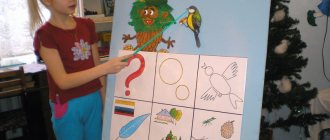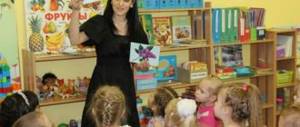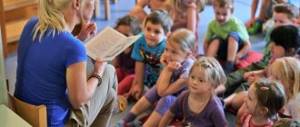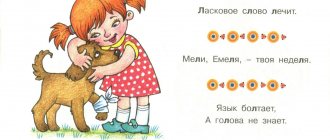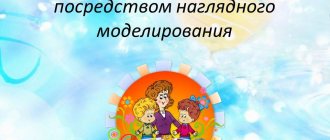We play, we talk, we think: a program for the speech development of preschoolers
Kamaldinova G.M., Virfel T.M., Mikhailova L.P. We play, we talk, we think: a program for the speech development of preschoolers // Sovushka. 2020. N 4 (18). URL: https://kssovushka.ru/zhurnal/18/ (date of access: 10.10.2020).
Order No. 427652
APPENDIX: Full version of the program with applications (brochure)
Explanatory note
Speech is the most important creative mental function of a person, the area of manifestation of the inherent ability of all people for cognition, self-organization, self-development, for building one’s personality, one’s inner world. Dialogue, creativity, cognition, self-development - these are the fundamental components that are involved in the sphere of attention of the teacher when he addresses the problem of speech development of a preschooler.
Currently, scientists and teaching practitioners note a decrease in the level of speech development of preschool children. With spontaneous speech development, only a few children reach a sufficiently high level, so teachers need to pay close attention to children with problems in speech development.
Preschool age is a period of active acquisition by a child of spoken language and communication skills. Full mastery of speech in preschool childhood is a necessary condition for solving the problems of mental, aesthetic and moral education of children in the most sensitive period of development.
Relevance
In modern conditions of preschool childhood, one of the most difficult and biggest problems in teaching preschool children is to teach them to speak coherently and expressively. It is very important to help your child master this wonderful gift.
A child talks a lot in everyday life, communicating with peers and adults. However, when an adult asks a child to tell him what interesting things he saw at the zoo, to retell a fairy tale, a story, to describe a picture, to compose a story based on a picture, then difficulties immediately arise. The child does not know how to see and understand the main plot, identify the main characters, the main action, the location of the action, the time and place of the event, and cannot clearly formulate a question and answer it. His speech becomes episodic, incomplete, inexpressive.
By the age of 5–6 years, a modern child must master all components of speech: correctly pronounce all sounds and words of a complex sound-syllable structure, be able to fully and consistently express his thoughts, constructing complex, detailed sentences, logically justifying his statements, freely retell stories, describe pictures, events.
The “Play, Talk, Think” program allows you to solve the problems of speech development of children from primary preschool to senior preschool age with a gradual complication of the tasks of forming grammatically correct, lexically rich and phonetically clear speech, which provides the opportunity for communicative communication and prepares them for learning at school.
Purpose of the program
Create conditions for the development of speech and communication skills of children.
Program objectives
- Enriching children's vocabulary and activating vocabulary.
- Formation of the grammatical structure of speech.
- Formation of sound culture of speech.
- Formation and development of coherent speech.
- Formation of the need to independently enter into dialogue.
- Developing the ability to argue your conclusions.
- Liberate the child, give him the opportunity to make public his reaction, his impressions of various events.
- Creation of a comprehensive integrated model of correctional and developmental activities of preschool specialists as a condition for the child’s speech development.
Distinctive features of the program
The speech development program “We Play, Talk, Think” is designed to work with children 4 – 7 years old.
This program has a concentric structure. In each subsequent year of study, the content expands and deepens, building on previous knowledge.
First year of study: Sensory education (development of visual perception, auditory perception).
Second year of study: Development of thinking.
Third year of study: Speech development.
The choice of such a structure is due to the fact that the state of the pronunciation and content aspects of speech, the level of speech development are directly dependent on the level of formation of attention and sensory processes; the ability to independently calculate the properties of objects that are significant for solving each specific problem, the ability to make independent generalizations, and independently find a choice for solving a practical problem in an unfamiliar situation. Work on the development of children's speech takes place in a certain sequence: from simple to complex. In all three years of study, the tasks of educating the sound culture of speech, forming a vocabulary and grammatical structure of speech, and developing coherent speech are solved.
At the age of 4-5 years (I year of study), training is aimed at developing visual perception, tactile-motor perception, speech breathing; on the development of articulatory motor skills, phonetic hearing and speech attention in children; which prepares them for the sound culture of speech, the full mastery of phrasal speech.
At the age of 5-6 years (second year of study), the lexical and grammatical structure of speech is improved, basic mental processes (attention, memory) are formed, a critical style of thinking and behavior is formed, the key characteristic of which is dialogue between an adult and a child, between children.
At the age of 6–7 years (III year of study), critical thinking develops, the ability to substantiate one’s opinion and understand the positions of other people, speech and communication skills develop, and self-confidence increases.
The proposed additional program is adapted, the following sources were taken as a basis:
- Leongard E.I. Communication" education and training of hearing-impaired preschool children in kindergarten: program, Moscow 1996.
- Isaeva G.I. The starting point is the child: a methodological manual. Kazan, 2003.
- Tkachenko G.A. Learning to speak correctly: methodological manual and demonstration material for speech therapists, educators and parents, M.: GNOM D, 2003.
This “Play, Talk, Think” program is based on the ideas of the above authors, and also includes some of their theoretical materials and practical tasks.
The implementation of this program involves:
- increasing self-confidence in children;
- mastering the rules of conversational speech, free use of vocabulary and grammar when expressing one’s thoughts and composing any type of statement.
- development of a culture of communication, the ability to come into contact with adults and peers: listen, answer, object, ask, explain.
- knowledge of the norms and rules of speech etiquette, the ability to use or depending on the situation.
Organization of the educational process
Duration of the program : within 3 years. The program is designed to work with children 4 - 5 years old, 5 - 6 years old, 6 - 7 years old.
Leading forms of work : classes, games, scenarios that activate learning.
Duration of classes depending on the age of children: average age - 20 minutes, older age - 25 minutes, pre-school age - 30 minutes.
The program consists of three sections:
Section 1 – diagnostic
Diagnostics is the initial and final stage of working with the child and the group as a whole. A speech therapist conducts an examination of children's speech, teachers and a psychologist monitor the behavior of children during communication and the relationships between children in kindergarten.
Section 2 – practical
In the practical part, problems of speech and communication development of children are set and solved. The goal of the teacher is to awaken the child’s speech activity, his language abilities, and create situations of dialogue between children. The teacher organizes the children’s activities so that the activity does not act as a form of learning, it can be leisure, entertainment, games, reading books, looking at illustrations, paintings, artistic creativity, etc. When using activating communication scenarios, learning occurs both in class and outside class, throughout the day, and is integrated in nature with the active use of gaming techniques.
Goals and objectives of the activity:
- formation and development of articulatory motor skills to the level of minimal sufficiency for producing sounds;
- enrichment and activation of vocabulary;
- formation of the grammatical structure of the child’s language;
- development of coherent speech;
- development of sound culture of speech;
- developing the ability to work with pictures;
- development of the ability to clearly, clearly, expressively express one’s communicative intention in speech.
- develop the ability to listen carefully to your interlocutor;
- develop the ability to argue your conclusions.
Section 3 – control
Control is carried out using all diagnostic materials. After the completion of the school year, the level of speech and communication development is revealed.
The data is compared with the original diagnostic data.
An in-depth analysis of the results helps to formulate further work with children, develop an individual educational route for the child with goals for further education, and also determine recommendations for teachers and parents.
Methodological support of the program:
The main forms and methods are: diagnostics, individual and group conversations, creating a situation of success; conducting phonorhythmics of speech exercises; Conversations based on pictures with simple and problematic stories.
When conducting exercises with pictures, toys, objects, a large place is given to such a technique as a question. The direction and content of children’s mental activity depends on the verbal formulation of the question; the question should evoke the child’s mental activity.
Didactic and technical support of the program:
Toys, dummies, plot and subject pictures, pictures with a problematic plot, illustrations, colored pencils, a didactic “wonderful bag”, works of children's fiction, musical works, a tape recorder, a projector, a multimedia screen and other visual aids are used.
Literature:
- Arushanova A.G. Development of dialogic communication: Speech and verbal communication of children: a methodological manual for educators M: Mozaika - Synthesis, 2008.
- Bychkova S.S. Formation of communication skills with peers in older preschoolers: methodological recommendations for educators and methodologists of preschool educational institutions. M.: Arkti, 2003.
- The starting point is the child: a methodological manual / author - compiler R.I. Isaeva. Kazan, 2003.
- Leongard E.I. Communication: program
- Education and training of hearing-impaired preschool children in kindergarten. M., 1996.
- Development of speech and creativity in preschoolers. Games, exercises, lesson notes. / ed. Umakova O.S. M.: TC Sfera, 2002.
- Skorolupova O.A. Introduction of the Federal State Educational Standard for Preschool Education. M.: Scriptorium, 2014.
- Tkachenko T.A. Learning to speak correctly: methodological guide and demonstration material for speech therapists, educators and parents. M.: GNOM i D, 2003.
Full version of the program with applications (brochure)
Work program for speech development in the preparatory class.
Department of Education of the Administration of Yoshkar-Ola
Municipal budgetary educational institution
"Secondary school No. 10"
WORKING PROGRAMM
preparatory class for speech development
" The world around us"
(
This is a practical course for working with preschoolers in the preparatory class on speech development based on the study of lexical topics)
(30h, 1h per week)
Author – speech therapist teacher T.I. Kundel
Explanatory note.
Currently, the school solves the complex problem of education and upbringing of the younger generation - the personal development of the child (readiness and ability for self-development, formation of motivation for learning and knowledge) on the basis of his mastering universal educational actions (regulatory, cognitive, communicative), knowledge and mastery of the world.
A child at school must be mature not only physiologically and socially, but also achieve a certain level of mental and emotional-volitional development. Educational activity requires the necessary stock of knowledge about the world around us, the formation of elementary concepts, and a sufficiently high level of speech development. The child must master mental operations, be able to generalize and differentiate objects and phenomena of the surrounding world, be able to plan his activities and express his knowledge and skills through speech.
Classes on the course “The World Around Us” are aimed at the diversified development of the child through various types of speech activities. During classes, children systematize previously accumulated knowledge about the world around them, acquire new ones, learn to share impressions, tell stories, and compose.
The system is based on an integrated approach; a methodology has been developed aimed at solving different but interrelated tasks in one lesson, covering different aspects of speech development (phonetic, lexical, grammatical), and on their basis solving the main task - the development of coherent speech through knowledge of the environment peace.
Most classes are structured on a thematic basis, i.e. Children's exercises and statements begin, continue and develop one topic. The topics of the classes are very diverse: the seasons, the world of animals and plants, phenomena of social life, relationships between adults and children, love of nature.
Training is based on gaming activities and is practical in nature. Speech games are of particular importance when working on speech. They develop thinking, speech, attention, imagination. These are, for example, the games “Give me a word”, “Make a word”, “Guess the word”, “Make a riddle”, “Continue the fairy tale”, “Continue the story”, “Repeat quickly and correctly”, “Tell about the toy (color, shape , size)”, “Name the sound”, “Choose words for a given sound”, “Guess the word”, etc.
This program includes such areas of speech development as:
- expansion and activation of children’s vocabulary: enriching the child’s vocabulary with words denoting actions, attributes of objects, words with direct and figurative meanings, diminutive suffixes,
- using new words in one’s own speech, constructing phrases and sentences,
- development of skills and abilities of coherent monologue and dialogic speech:
answering questions, participating in dialogue;
- retelling a story, fairy tale based on illustrations, based on questions from the teacher;
- compiling a story based on a painting, drawings and illustrations for a work;
- a story based on personal observations and impressions;
- compiling riddles, fairy tales, stories;
- verbal drawing
- learning riddles, tongue twisters, proverbs
- acquaintance with works of art.
— developing children’s interest in independent verbal creativity, encouraging the creation of stories, fairy tales, and poems.
- formation of basic skills of speech culture, correct speech behavior, listening skills.
The purpose of the classes,
carried out under the program “The World Around Us” - to promote a more solid and conscious assimilation of knowledge about the world around us, to promote the development of children’s speech, to develop the sound and lexical aspects of speech, to improve their word formation skills, to increase the level of language development, to cultivate cognitive interest in their native language, solve problems of intellectual development.
Tasks
course "The World Around Us" are:
— children’s accumulation of sufficient vocabulary on basic lexical topics;
- assimilation of accessible initial information about the world around us;
-mastery of simple grammatical forms and syntactic structures;
— creation of speech situations that stimulate the motivation of children’s speech development;
— formation of speech interests and needs of preschool children; — improving the skills of oral coherent speech, monologue and dialogic, based on the child’s speech experience;
— development of phonemic hearing, improvement of the sound culture of children’s speech.
The most important feature of the course is its communicative orientation,
which involves targeted training of preschoolers to carry out various types of speech activities.
The second feature is that the content of the program is constructed as a synthesis of various components of natural science and environmental knowledge.
The third feature of the course is related to the setting of the learning process: based on the language experience and natural linguistic intuition of children, an activity-based approach to studying the surrounding world and their native language and further practical mastery of it is implemented.
During classes on the proposed course, children develop developed forms of self-awareness and self-control, their fear of making wrong steps disappears, anxiety decreases, prerequisites for creativity are created, and the desire for knowledge develops.
Personal, meta-subject (prerequisites) for mastering the program.
As a result of classes in the “The World Around Us” program, the senior preschooler will develop the following prerequisites for achieving personal and meta-subject (regulatory, cognitive, communicative) results and subject results.
Personal results (prerequisites for their achievement)
preschool training is the formation of the following skills: .
- appreciate and accept the following basic values: “goodness”, “patience”, “homeland”, “nature”, “family”.
- respect for your family, for your relatives, love for your parents.
— determine
and
express
, under the guidance of a teacher, the simplest rules of behavior common to all (ethical standards);
- in situations of communication and cooperation proposed by the teacher, based on simple rules of behavior common to everyone, make a choice
what to do (with the support of the teacher);
- with the support of the teacher and others, give an assessment
your actions and the actions of other people;
— understand
that the assessment of his actions and motives is determined not so much by his own attitude towards himself (I am “good”), but primarily by how his actions look in the eyes of the people around him;
— to express
your emotions, observing ethical standards;
— understand
emotions of other people, sympathize, empathize;
— express
your attitude towards the heroes of literary works, their actions;
— explain
, wants to go to school or not, and why.
Formation of positive motivation for learning activities: “I want to learn!” - the most desired planned personal result.
Meta-subject results (prerequisites for their formation)
preschool preparation is the formation of the following universal educational actions (hereinafter referred to as UUD): regulatory, cognitive, communicative.
Regulatory UUD:
- learn to identify
and
formulate
the purpose of the activity in class with the help of the teacher;
- learn to work
according to the plan proposed by the teacher;
- learn to speak
sequence of actions in the lesson;
- learn to express
your assumption (version) based on working with the material (illustrations)
- learn to distinguish
a correctly completed task from an incorrect one;
- learn together with the teacher and other children to give
emotional
assessment
of one’s activities in class and the activities of the entire class;
- learn to evaluate
the results of your work.
Cognitive UUD:
— learn to navigate your knowledge system: distinguish
new from the already known;
- learn to navigate
in the textbook (on the double page, in the table of contents, in the legend);
- learn to find answers
to questions in illustrations;
— compare
and
group
various objects (numbers, geometric shapes, subject pictures);
— classify
and
generalize
based on life experience;
- learn to draw conclusions
as a result of joint work with the teacher;
- learn to transform
information from one form to another (compose mathematical stories based on object drawings and simple models, replace a word or sentence with a diagram).
Communication UUD:
— call
your last name, first name, home address;
— listen
and
understand
the speech of others;
— learn to navigate
to the position of other people, different from your own, to respect a different point of view;
- learn to design
your
thoughts
verbally;
— build
statements
that are clear to the partner ;
— be able to ask questions
in order to use them to obtain the necessary information from the activity partner;
negotiate with the teacher
with other children about the rules of behavior and communication and learn to follow them;
— keep
a friendly attitude towards each other not only in cases of common interest, but also in situations of conflicts of interest that often arise in practice;
- learn to perform
different
roles
when working together.
Expected Result:
—
mastering initial knowledge about the world around us;
- mastery of the native language at a higher level;
-development of the child’s intellectual abilities through mastery of words as a tool of communication and thinking.
The work program is designed for 30 hours (1 hour per week).
Calendar and thematic planning of classes
| № | Topics of classes on speech development | Lexical topic | Watch |
| 1. | Speech. The concept of speech culture | Nature is living and inanimate. | 1 |
| 2. | The basics of speech quality: correctness, precision, richness. | Autumn. Signs of autumn. | 1 |
| 3. | Means of speech expression: tempo, timbre, intonation. Teaching a leisurely pace and rhythm of speech, correct speech breathing, moderate volume and correct intonation | Vegetable world. Trees. Shrubs.Herbs. | 1 |
| 4. | The word, its meaning. Where do words come from? | Animal world. Domestic and wild animals. | 1 |
| 9. | Correct use of words - names of objects, signs, actions; explanation of their meanings | Vegetable world. Vegetables and fruits. | 1 |
| 10. | Words-friends | Mushrooms - edible and inedible. Rules for collecting mushrooms. | 1 |
| 11. | Words with opposite meanings | Animal world. Baby animals. | 1 |
| 12. | Polite words | Birds. | 1 |
| 13. | Concept of offer | Winter. Signs of winter. | 1 |
| 14. | Sentences with different intonation | Fish. | 1 |
| 15. | Editing offers | Insects. | 1 |
| 16. | Making proposals on the issue | Subject world. Toys. | 1 |
| 17. | Making proposals on a topic | Subject world. Clothes and shoes. | 1 |
| 18. | Making proposals for a painting | Me and society. Our country. | 1 |
| 19. | Concept of text. Connection between sentences in txt. | Me and society. My family. | 1 |
| 20. | Figurative means of language (comparisons, personification) | Me and society. Professions. | 1 |
| 21. | Winged words and expressions. | Spring . signs of spring. | 1 |
| 22. | Writing a story based on questions. | Vegetable world. Flowers. | 1 |
| 23. | Compiling a story based on a series of paintings. | Vegetable world. Berries. | 1 |
| 24. | Compose a story using supporting words and a picture. | Inanimate nature.. | 1 |
| 25. | Compiling a story based on a picture. | Transport. | 1 |
| 26. | We learn to compose and fantasize. | Equipment in everyday life. | 1 |
| 27. | Essay on reference words. | I am a future school student. | 1 |
| 28. | Writing riddles. | Sport. | 1 |
| 29. | Writing a fairy tale | Summer. Signs of summer. | 1 |
| 30. | Check yourself. | 1 |
Literature
- Fedosova N.A. Preschool education: Preparing for school. – M.: Education, 2009.
- Fedosova N.A. From word to letter: A textbook for preparing children for school: in 2 hours - M.: Education, 2009.
- Fedosova N.A. , Ignatieva T.V.
Speech development. Additional material. Fairy tales, stories, poems for reading to children. // Vlados, 2000.
- Volodina N.V. I speak beautifully: for children 6 - 7 years old: at 2 o'clock - M.: Eksmo, 2011. (Lomonosov school)
- Sozonova N.N., Kutsmna E.V., Khrushkova N.G. Phonetic stories and fairy tales (for children 5 – 7 years old). At 3 o'clock - Ekaterinburg: Knigomir LLC, 2010.
- Bezrukikh M.M. Steps to the school. A book for teachers and parents. -M.: Bustard, 2000.
- Volina V. Learning by playing. - Moscow, “New School”, 2001.
- Bezrukikh M.M., Is the child ready for school? M. "Venta-Graf", 2001
- Zueva L.N., Kostylev N.Yu., Solomenko O.P.
Entertaining exercises for speech development for preschool children. Didactic albums (No. 1,2,3,4) – Astrel – AST
- Chistyakova O.V. The world around us.-St. Petersburg, 2009.
- Tsukerman G.A., Polivanova N.K. Introduction to school life. OGOUDPO "Kursk Institute of Continuing Professional Education (PKiPP) of industry specialists", 2007.
